Loss of circadian rhythmicity in aging mPer1-/-mCry2-/- mutant mice
- PMID: 12782655
- PMCID: PMC196069
- DOI: 10.1101/gad.256103
Loss of circadian rhythmicity in aging mPer1-/-mCry2-/- mutant mice
Abstract
The mPer1, mPer2, mCry1, and mCry2 genes play a central role in the molecular mechanism driving the central pacemaker of the mammalian circadian clock, located in the suprachiasmatic nuclei (SCN) of the hypothalamus. In vitro studies suggest a close interaction of all mPER and mCRY proteins. We investigated mPER and mCRY interactions in vivo by generating different combinations of mPer/mCry double-mutant mice. We previously showed that mCry2 acts as a nonallelic suppressor of mPer2 in the core clock mechanism. Here, we focus on the circadian phenotypes of mPer1/mCry double-mutant animals and find a decay of the clock with age in mPer1-/- mCry2-/- mice at the behavioral and the molecular levels. Our findings indicate that complexes consisting of different combinations of mPER and mCRY proteins are not redundant in vivo and have different potentials in transcriptional regulation in the system of autoregulatory feedback loops driving the circadian clock.
Figures
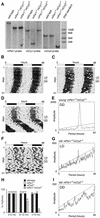

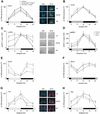
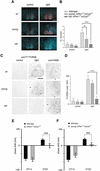
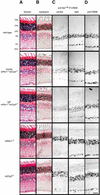
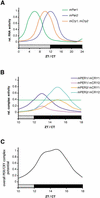
Similar articles
-
Daily variation of clock output gene activation in behaviorally arrhythmic mPer/mCry triple mutant mice.Chronobiol Int. 2003 Jul;20(4):683-95. doi: 10.1081/cbi-120022408. Chronobiol Int. 2003. PMID: 12916720
-
Disruption of mCry2 restores circadian rhythmicity in mPer2 mutant mice.Genes Dev. 2002 Oct 15;16(20):2633-8. doi: 10.1101/gad.233702. Genes Dev. 2002. PMID: 12381662 Free PMC article.
-
Analysis of clock proteins in mouse SCN demonstrates phylogenetic divergence of the circadian clockwork and resetting mechanisms.Neuron. 2000 Feb;25(2):437-47. doi: 10.1016/s0896-6273(00)80906-x. Neuron. 2000. PMID: 10719897
-
Cellular and molecular basis of circadian timing in mammals.Semin Perinatol. 2000 Aug;24(4):243-6. doi: 10.1053/sper.2000.9122. Semin Perinatol. 2000. PMID: 10975430 Review.
-
Cryptochrome: the second photoactive pigment in the eye and its role in circadian photoreception.Annu Rev Biochem. 2000;69:31-67. doi: 10.1146/annurev.biochem.69.1.31. Annu Rev Biochem. 2000. PMID: 10966452 Review.
Cited by
-
Opposing actions of Per1 and Cry2 in the regulation of Per1 target gene expression in the liver and kidney.Am J Physiol Regul Integr Comp Physiol. 2013 Oct 1;305(7):R735-47. doi: 10.1152/ajpregu.00195.2013. Epub 2013 Jul 3. Am J Physiol Regul Integr Comp Physiol. 2013. PMID: 23824961 Free PMC article.
-
Meal time shift disturbs circadian rhythmicity along with metabolic and behavioral alterations in mice.PLoS One. 2012;7(8):e44053. doi: 10.1371/journal.pone.0044053. Epub 2012 Aug 27. PLoS One. 2012. PMID: 22952870 Free PMC article.
-
Cryptochrome restores dampened circadian rhythms and promotes healthspan in aging Drosophila.Aging Cell. 2013 Oct;12(5):752-62. doi: 10.1111/acel.12100. Epub 2013 Jun 25. Aging Cell. 2013. PMID: 23692507 Free PMC article.
-
A guideline for analyzing circadian wheel-running behavior in rodents under different lighting conditions.Biol Proced Online. 2005;7:101-16. doi: 10.1251/bpo109. Epub 2005 Jul 13. Biol Proced Online. 2005. PMID: 16136228 Free PMC article.
-
From clock to functional pacemaker.Eur J Neurosci. 2020 Jan;51(1):482-493. doi: 10.1111/ejn.14388. Epub 2019 May 2. Eur J Neurosci. 2020. PMID: 30793396 Free PMC article. Review.
References
-
- Albrecht U. 2002. Invited Review: Regulation of mammalian circadian clock genes. J. Appl. Physiol. 92: 1348–1355. - PubMed
-
- Albrecht U. and Foster, R.G. 2002. Placing ocular mutants into a functionalcontext: A chronobiological approach. Methods 28: 465–477. - PubMed
-
- Albrecht U. and Oster, H. 2001. The circadian clock and behavior. Behav. Brain Res. 125: 89–91. - PubMed
-
- Albrecht U., Sun, Z.S., Eichele, G., and Lee, C.C. 1997. A differential response of two putative mammalian circadian regulators, mper1 and mper2, to light. Cell 91: 1055–1064. - PubMed
-
- Albrecht U., Lu, H.-C., Revelli, J.-P., Xu, X.-C., Lotan, R., and Eichele, G. 1998. Studying gene expression on tissue sections using in situ hybridization. In Human genome methods (ed. K.W. Adolph), pp. 93–119. CRC Press, New York.
Publication types
MeSH terms
Substances
LinkOut - more resources
Full Text Sources
Medical
Molecular Biology Databases
